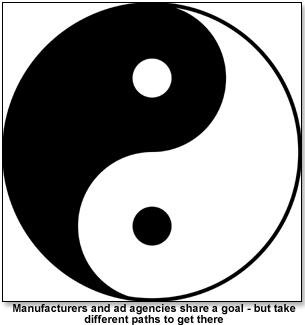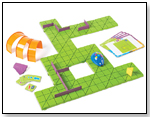|
|
Toy Advertising – The Differing Perspectives Ad Agency and Toy CEO Go Head to HeadThe Concise Encyclopedia defines advertising as “Techniques and practices used to bring products, services, opinions, or causes to public notice for the purpose of persuading the public to respond in a certain way.” If you accept the industry-wide belief that children are the primary deciders for toys, not their parents, and if you look at this against a background where the major media – TV, Cinema, Radio and Magazines – all experience declining audience numbers of this consumer group, then the decisions underpinning advertising strategies become incredibly important. More so, these processes must take into account that the two main partners in it – the manufacturer and the ad agency – come to the party from very different directions.  ************ What are your criteria for accepting a new client? David Becker: We like bringing on new business but we do look at several factors before taking on a new client. For us, we’ve come to realize, over the years, that we don’t have to work with everyone. Since we believe in entering partnership relationships, which often turn into friendships, we believe in working with clients who we respect, who challenge us, and who we feel we can work with...and grow with. Because we believe in educating our clients and immersing them in the media process, we look for clients who are seeking a partner relationship vs. a vendor relationship. They typically have an understanding of the media process yet rely on us to dig deep for answers - and to substantiate our thinking with supportive research. They challenge us, are willing to take (supported) risks and stand by us when it is reasonable to do so. Lastly, due to the sensitivities, it is important to protect our clients by avoiding direct competitive clients. What are your criteria for selecting a new ad agency? Toy Manufacturer: The first criterion is integrity. I do not want to work with anybody who has any agenda other than doing the best possible job for me. He does not have to be specialized in toys but needs to have a demonstrated success record in packaged consumer goods. I look for somebody who is ready to defend his views, who is not afraid to disagree with me, and who can back up his assertions with solid research. He also needs to know the ropes as far as emerging new media are concerned – social media being a case in point. He also needs to have all the resources you typically expect from an ad agency and be ready to give me chapter and verse on them. ************ What are the questions you ask an existing client who comes to you with a new product? David Becker: There are many questions that rise to the top. In fact, we have a list of 50 questions we typically ask during the new product probing process. Our focus is on gaining a deep understanding of the clients’ new brand or product and of the purchaser and end user. We interrogate every aspect of the business problem we’ve been tasked with solving. The objective is simple: to discover new and fresh insights that can drive our strategy. It is important to note that clients search for agencies at different stages of the marketing process. Part of our process is to identify and define the product stage and the challenge at hand. For instance, are we in the competitive analysis stage, strategic planning stage, media planning stage or the buying and campaign management stage? The obvious first question, “What is the product?” I often like to share with new clients my favorite quote from Bill Bernbach, “Good advertising will make a bad product fail faster” So, is your product any good? What differentiates it in the market? Do you need to drive industry awareness in order to drive sell-in and/or are you focusing on targeting the consumer to drive sell through? Who is your primary target and is there a secondary audience? What are your distribution channels, retailer terms, on shelf dates? What are your sales goals and campaign objectives? What is your media budget? Creative assets? What metrics will you use to measure the success of the campaign and the success of the media agency responsible for planning, buying and managing your campaign? What are the questions you would ask the agency in regard to a new product? Toy Manufacturer: After having sat down with the ad agency and answered all their questions about the product and my plans for it, I would leave a bunch of finished prototypes including packaging with the agency for about two weeks and then return to ask my questions: What have you done with the product in the last two weeks? What do your kids think about it? What stores have been to see what other products are in the same aisle? Do you like the product and why? What are the steps and the time schedule between today and the finished campaign? Have you found anything that contradicts what I told you in our first meeting? *********** What is the primary objective of an advertising campaign focused on toys? David Becker: The primary objective for most toy marketers, at the end of the day, is to sell toy product and increase their customer base in an effort to sell them even more product. If you want to increase your customer base, you have to drive awareness. To drive awareness, you have to build reach. We are also big believers in the power of engagement and time spent with your brand. Any smart advertising campaign must target the appropriate audience. The right message to the wrong audience at the wrong time is a recipe for failure, a dilution of your advertising’s effectiveness, and a sure fire way to burn through your media dollars with little market impact. What do you consider the primary objective of an advertising campaign for one of your new products? Toy Manufacturer: It must quite clearly be to sell product and to increase market share for my company. Having said this, it must also tie in with the other ongoing promotional efforts for the product or vice versa. In other words, an advertising campaign does not exist in a vacuum. Yes, it must reach the consumer and drive the consumer to the store (or online, as the case may be) but it must also seamlessly work with what the stores are doing with the product. In other words, if the ad campaign has boys as a focus but the stores put the product into the Girls aisle then we have a disconnect that needs to be addressed. ************ Is there a minimum time span for which you should plan an advertising campaign? David Becker: The campaign should align with the appropriate selling season. For instance, a summer item might have an extremely tight window, from May through June. Come July, they might already be taking markdowns. An Easter toy campaign might focus on the three weeks leading into Easter. Post-Easter might come into play. Holiday requires a longer flight. Different categories spur different shopping patterns that can alter the time span from which you’ll run your campaign. Rely on experience and industry/consumer research to substantiate your flighting decisions. Toy Manufacturer: The funding for the campaign is part of the budgetary process, which is a twelve-month period. Within that period, the time span is dictated by the seasonality profile of the product. If it is clearly a Christmas item, shipped in September, then the campaign must be in sync with this. Whether the campaign should start before the launch or afterwards, and when exactly, is a judgement call. Having said this, my instincts are always to start the campaign early in the season and concentrate your spending in the first two-thirds of the campaign, hoping that the momentum so generated will allow you to coast to the finish line during the last third. ************ How do you determine the minimum threshold in terms Dollars or of spots or ads for a nationwide campaign? David Becker: From an agency perspective, when establishing minimums, it comes down to minimum communication requirements. To sell product you need to drive awareness and that means delivering target audience reach above 75% and covering 2/3rds of the selling season with advertising weight. The toy category is highly competitive and so minimum communication levels must be balanced with levels required to have equal or higher share-of-voice vs. competitive toys and toy categories. For seasonal campaigns - that minimum communication and competitive threshold works out to $1.5 million and higher. What do you typically budget for such a campaign? Toy Manufacturer: This tends to be a complicated process. Firstly, you arrive internally at minimum and maximum sales forecasts for the product for the year on the basis of your research into competitive products. You then assess the more precise sales level by gauging the reception the product got during the presentation stage with the buyers. Some will even give you input as to what they would like to see in terms of media support. Then you go back and run the numbers. Once you have a number, you talk to your advertising agency and listen to their proposals. In my experience, any nationwide campaign, particularly for a fourth-quarter product, will run into several million Dollars. If the numbers do not allow this, you probably do not have a product. ************ Will the campaign differ if the products are sold in mass or specialty stores? David Becker: Of course. As they say, “put your money where your market is”. To spend media money nationally if your product is sold in key regions is not a smart move and not leveraging your media investment wisely. If you are selling mass, you will likely rely on national messaging, across relevant platforms. If you are selling specialty, we often ask our clients to send us a zip code list of all specialty stores carrying product. We take those zips and develop a list of markets that reach the greatest concentration of stores from which we map our market-to-market media strategy. We build a bottom-up vs. top down approach…leveraging local media options and efficiencies where appropriate. Would your agency selection differ if a product is to be sold in mass retail or in specialty only? Toy Manufacturer: I cannot answer this question since I would never launch a product designed for Specialty only. My prime target will always be Mass plus Amazon. Any sales I get from Specialty would be a bonus. ************ How do you measure whether the advertising campaign has been a success or a failure? David Becker: A media campaign supports the product going in and going out. What I mean by that is that today’s retail buyers are looking to you as a partner. They want to see what you will do to support your brand. The answer to that question will directly impact your sell in numbers. So, part of your success is based on a successful sell in. The second part, of course, is sell through. Beyond sales, it is important to look at each medium’s metrics and measure its success. We believe in charting all media activity against product sales. We also look at web traffic, search queries and social dialogue, and analyze spikes in relation to advertising. We get a pretty good idea of the success of each component. We take those learnings and apply to future campaigns How do you measure whether the advertising campaign has been a success or a failure? Toy Manufacturer: Have shipments been on target? Have I gained the market share I set out to get? Are the buyers happy with their results for the product? ************ And, of course, there is always the fee structure:   Writer's Bio: Lutz Muller is a Swiss who has lived on five continents. In the United States, he was the CEO for four manufacturing companies, including two in the toy industry. Since 2002, he has provided competitive intelligence on the toy and video game market to manufacturers and financial institutions coast-to-coast. He gets his information from his retailer panel, from big-box buyers and his many friends in the industry. If anything happens, he is usually the first to know. Read more on his website at www.klosterstrading.com. Read more articles by this author Writer's Bio: Lutz Muller is a Swiss who has lived on five continents. In the United States, he was the CEO for four manufacturing companies, including two in the toy industry. Since 2002, he has provided competitive intelligence on the toy and video game market to manufacturers and financial institutions coast-to-coast. He gets his information from his retailer panel, from big-box buyers and his many friends in the industry. If anything happens, he is usually the first to know. Read more on his website at www.klosterstrading.com. Read more articles by this author |
| ||||||||||||||||||||||||||||||||
Disclaimer Privacy Policy Career Opportunities
Use of this site constitutes acceptance of our Terms of Use.
© Copyright 2025 PlayZak®, a division of ToyDirectory.com®, Inc.



